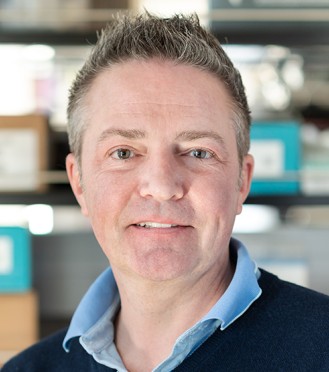Gladstone NOW: The Campaign Join Us on the Journey✕

Benoit Bruneau, director of the Gladstone Institute of Cardiovascular Disease, shares exciting recent advances in heart research and talks about the impact of predictive AI.
Fast or slow, steady or shaky, the beat of our hearts is the background to our lives. This vital organ is with us through thick and thin, doing its best to pump blood that delivers nutrients and oxygen to cells throughout the body.
We owe the life-supporting beat of the heart to the complex interplay of its cellular, genetic, and molecular characteristics. But when things go awry, the effects can be devastating.
Cardiovascular disease is the world’s leading cause of death. Millions of people are living with heart failure, and more than one million babies are born with congenital heart defects every year.
For Benoit Bruneau, PhD, director of the Gladstone Institute of Cardiovascular Disease, the situation is deeply personal—his father is in chronic heart failure due to a heart attack, and his teenage daughter was born with a congenital heart condition. His lab is using advanced tools and strategic collaborations to improve knowledge of how a healthy heart develops, exactly what can go wrong, and the most promising paths to fix it.
“Our goal is to unite researchers with completely different areas of expertise who, together, can make discoveries that would otherwise be impossible.”
Other scientists at Gladstone Institutes are also studying the heart from every angle, combining a broad suite of genetic, molecular, computational, and engineering technologies with the ultimate aim of providing better solutions to people who face cardiovascular disease.
As Gladstone commemorates World Heart Month, we spoke with Bruneau about the most exciting recent advances in heart research, and what’s on the horizon.
Millions of people and families are impacted by heart failure, where the heart struggles to pump enough blood to keep up with the body’s needs. Can you tell us about new strategies in the works that could help?
One of the discoveries I’m most excited about is in a fairly new field that looks at heart failure from a fresh perspective. For 50 years, researchers have mostly focused on the heart muscle cells that make the heart pump blood. But the heart also has other types of cells that all talk to one another—and in heart failure, how they talk to each other changes.
Now, people are exploring those communication changes, and Gladstone Investigator Michael Alexanian, PhD, is already one of the leaders in this emerging field. He discovered that fibroblasts, the structural cells of the heart, get “woken up” during heart failure and secrete nasty molecular messages to muscle cells, disrupting their pumping activity.

Research by Alexanian (right) and his colleagues suggests that heart failure could be tackled using drugs that dampen the response of fibroblasts to infiltrating immune cells.
Then, he took a step back to investigate what wakes up the fibroblasts. He identified the culprits as immune system cells circulating in the blood, which infiltrate the heart and secrete a molecule that activates the fibroblasts.
How could this work lead to new treatments?
It’s a real breakthrough because it suggests that, instead of tackling heart failure only with drugs that directly affect heart muscle cells, we could use drugs that dampen the response of fibroblasts to infiltrating immune cells. And in fact, Alexanian showed in mice that an injectable drug targeting a specific gene in fibroblasts can dampen this response.
His work is a proof of concept that this specific fibroblast gene is a druggable target. The drug is not yet ready for use in humans, but what’s exciting is that other researchers have independently made similar observations about communication between immune cells, fibroblasts, and heart muscle cells in humans. So that tells us this is a strategy worth pursuing.
About 1 percent of children are born with congenital heart defects. Could recent breakthroughs also help tackle this serious condition?
Absolutely, and this is an area where collaboration is really powerful.
We believe that in some babies, short stretches of DNA get deleted by chance from their genome before birth, in a way that’s not inherited from their parents. This is seen in very severe congenital heart defects, such as hypoplastic left heart syndrome.
My lab has been working with Katie Pollard, PhD, director of the Gladstone Institute of Data Science and Biotechnology. We’re trying to shed light on how these deleted stretches of DNA alter the 3D organization of a child’s genome in ways that may cause disease.

Bruneau is collaborating with Pollard (center) to uncover how missing stretches of DNA alter a child’s genome in ways that may cause severe congenital heart defects.
Even though these deletions are tiny, they can have major effects. That’s because each cell has about a meter of DNA in its nucleus—which is like taking a wire that reaches from New York to San Francisco and stuffing it into a backpack. But it’s not just stuffed in randomly; it’s very precisely organized according to the DNA sequence of the genome.
So even a small deletion can severely disrupt the 3D shape, which disrupts what genes get turned on and, ultimately, how the heart develops. It’s a layer of disease mechanism at the genome level that we didn't really anticipate.
How were you able to make this discovery?
What made this discovery possible was a sophisticated AI algorithm called Akita developed in Pollard’s lab. This algorithm predicts the complex 3D genome structure from just the linear DNA sequence, which is the simple combination of four types of bases—represented by the letters A, G, C, and T—that are found in a DNA molecule.
We combined Akita with two other flagship platforms at Gladstone—induced pluripotent stem cells and CRISPR gene editing—and found it can successfully perform even more difficult tasks than the popular tool called AlphaFold. And amazingly, we were able to confirm Akita’s predictions with experiments in the lab.
For clinicians, this is incredibly exciting. That’s because it would normally take a lengthy, expensive experiment to determine whether a child’s DNA deletion has anything to do with their heart defect. But this algorithm could be a powerful genetic screening platform to improve clinical decision-making.
How else is AI impacting heart research?
In general, what’s on the horizon to transform heart research is predictive AI. Every week, more studies come out about how you can use some clinical measurement in people to make interesting predictions.
For instance, researchers have applied predictive AI to a dataset containing measurements of the dimensions of the heart for thousands of people. It revealed how certain measurements correlate with the severity of a particular type of heart disease. That opens up the possibility of personalizing treatment according to people’s heart dimensions.
Gladstone Investigator Christina Theodoris, PhD, is doing amazing work as one of the leaders in predictive AI. She developed an incredible self-learning algorithm called Geneformer, which has already identified genes that could serve as novel potential drug targets for people with heart failure.

Theodoris (right) developed a predictive algorithm that has already identified novel potential drug targets for people with heart failure.
As a leader in heart research, is there anything else you’d like to highlight?
I want to emphasize the importance of collaboration in science, particularly among researchers with varied scientific disciplines. That concept is a driving force in the recruitments we make here at Gladstone. Our goal is to unite researchers with completely different areas of expertise who, together, can make discoveries that would otherwise be impossible.
This is key to making the big leaps forward in science that will have a huge, tangible impact on people with cardiovascular disease—and any other disease.
Featured Experts
Gladstone NOW: The Campaign
Join Us On The Journey
Science in Seconds | Researchers Pinpoint Key Gene Behind Heart Defects in Down Syndrome
Science in Seconds | Researchers Pinpoint Key Gene Behind Heart Defects in Down Syndrome
In this video, Gladstone scientists share how they used stem cells, gene editing, and AI to identify a gene driving heart defects in Down syndrome—and how reducing its levels in mice restored normal heart development, offering hope for future treatments
Gladstone Experts Cardiovascular Disease Data Science and Biotechnology Pollard Lab Srivastava Lab AI Big Data CRISPR/Gene Editing Human Genetics Stem Cells/iPSCsScience in Seconds | The Thinking Microscope: Research Powered by an AI Brain
Science in Seconds | The Thinking Microscope: Research Powered by an AI Brain
In this video, Steve Finkbeiner and Jeremy Linsley showcase Gladstone’s groundbreaking “thinking microscope”—an AI-powered system that can design, conduct, and analyze experiments autonomously to uncover new insights into diseases like Alzheimer’s, Parkinson’s, and ALS.
Gladstone Experts ALS Alzheimer’s Disease Parkinson’s Disease Neurological Disease Finkbeiner Lab AI Big DataVisualizing Stem Cell Technology: An Animated Explainer
Visualizing Stem Cell Technology: An Animated Explainer
In this animated short, Deepak Srivastava explains how scientists can reprogram ordinary skin or blood cells back in time—turning them into induced pluripotent stem cells which are capable of becoming any cell type in the body.
Gladstone Experts Stem Cells/iPSCs




